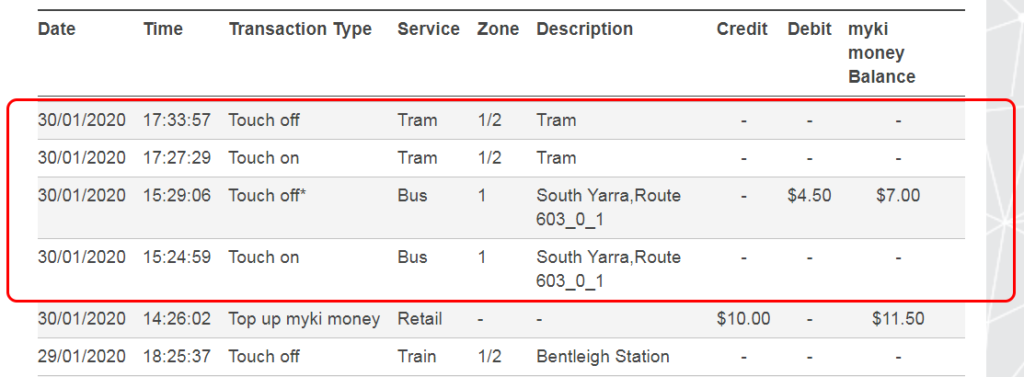I meant to post this ages ago, but… well… other things have been happening.
One afternoon in January I caught a bus. It was my first trip of the day. I was not using my usual Myki Pass at the time, and paid my fare using Myki Money on my phone.
The bus was in zone 1, so it charged me a two hour zone 1 fare of $4.50:
a 2 hour product authorises unlimited travel in the zone(s) travelled in until two hours after the myki was first touched on, except where the first touch on is made between 6pm and 12.59am, in which case the product expires at the end of the day. [3am]
– Fares and Ticketing Manual
Got that? The two hour fare applied until two hours after the touch-on, which was at 15:24. So the expiry time was 17:24.
All good so far.
Here’s where it gets interesting. At 17:27, three minutes after the original fare expired, I boarded a tram. A few minutes later I touched-off (not required, but I was interested in seeing response times on Mobile Myki).
Here’s the odd thing. Even though the second trip commenced more than two hours after the first, it didn’t charge me anything.
Here’s how it looks on the transaction history:

What could cause this?
Given I was using Mobile Myki (within Google Pay), what if the mobile phone’s clock was out of whack? Nope; the transaction display in Google Pay confirmed the times matched.
Could it be a glitch with the second touch-on (17:27:29) being less than two hours after the first touch-off (15:29:06). No – trying a similar combination of trips a few days later didn’t show this behaviour.
I puzzled over this, and eventually asked PTV to investigate. With my permission they looked at my account records to try and figure it out, and came back with an interesting answer.
And it’s got nothing to do with the time.
On a tram or bus, there are multiple Myki readers aboard, and they get signals from a “head unit” elsewhere on the vehicle.
It’s the head unit which is linked to GPS systems so that the Myki readers (theoretically) know the location of the vehicle, including which zone it’s in. This isn’t quite so critical for trams, which are almost always in zone 1, but it is important for buses, many of which cross zone boundaries.
Apparently in rare cases, an individual reader can lose its connection with the head unit, so it doesn’t know where it is.
The reader is designed in these cases to still touch people on and off, but not to charge a fare. That is, it takes a conservative approach and allows passenger to travel, but doesn’t risk over-charging them. This is what happened to me.
And by not simply shutting itself down, the reader avoids causing crowding or delays in doorways. The system will report the fault so that it can be checked later when the tram or bus comes out of service.
The two hours on my fare had expired, so why couldn’t it assume that another fare was due? Because fares don’t always last for two hours – for some regional trips a fare may last for up to four hours. And the code in the readers has apparently been kept fairly generic, so it doesn’t assume it’s in Zone 1 or 2 just because it’s a tram.
This occurrence, on a Z-class tram, happened to be just after the expiry of my original fare, so I scored a legitimate free ride.
What would have happened if Authorised Officers boarded and asked to see my ticket? I think the Mobile Myki (or card if that’s what I’d been using) would have shown the Myki reader had happily touched me on, so all good. (Remember, the fare isn’t charged until the following touch.)
This is not a bad design. It’s a form of defensive programming – the primary aim is to keep the system (not just the Myki system in this case, but the tram/bus and its passengers) running despite the fault, and not generate incorrect overcharges which then have to be sorted out later.
Myki has some well-documented issues (who on earth decided an online account can only have 8 cards?!) but I think this is clever.
It’s the kind of quirk you probably won’t find in the Fares & Ticketing Manual, and fair enough – it’s pretty obscure, and errs on the side of the customer.
It makes one wonder what other smarts are in the ticket system.


5 replies on “The Two Hour fare that wasn’t”
A fun tale in this era of (mostly) bad news. Thanks for sharing.
It is good to see the default for a comms breakdown is to NOT charge customers.
You are probably the only person to report a myki glitch that UNDERCHARGED you!
Of course pre-Myki your fare would have been valid until 18:00 anyway.
@namsupo, the rounding up to the next hour lasted well into the Myki era – it was removed in July 2014 (Myki started in 2009).
Should I say in this forum that since conductors have stopped checking Mykis on regional trains that I never touch off in Geelong after touching on at Footscray (or at Sunshine if I’ve caught a Metro train to change)? However I’ll always touch off at Sunshine on the way home, then touch on again but not touch off at West Footscray (where incidentally the new Platform 1 is really coming along). Also get the odd occasion where a bus thinks I’ve only travelled in Zone 2 because it’s Myki equipment is really lost.
Ah yes this quirk. It’d happened to me before but I never bothered to question why. Well, now I know. Thanks for chasing up the answer!